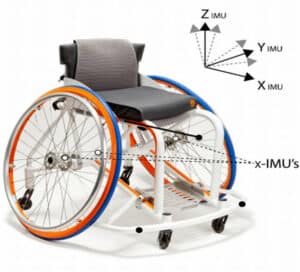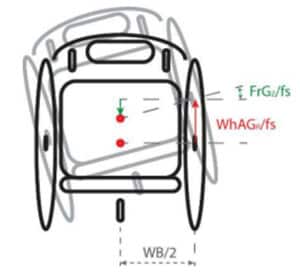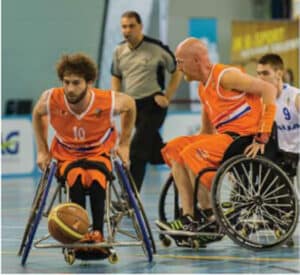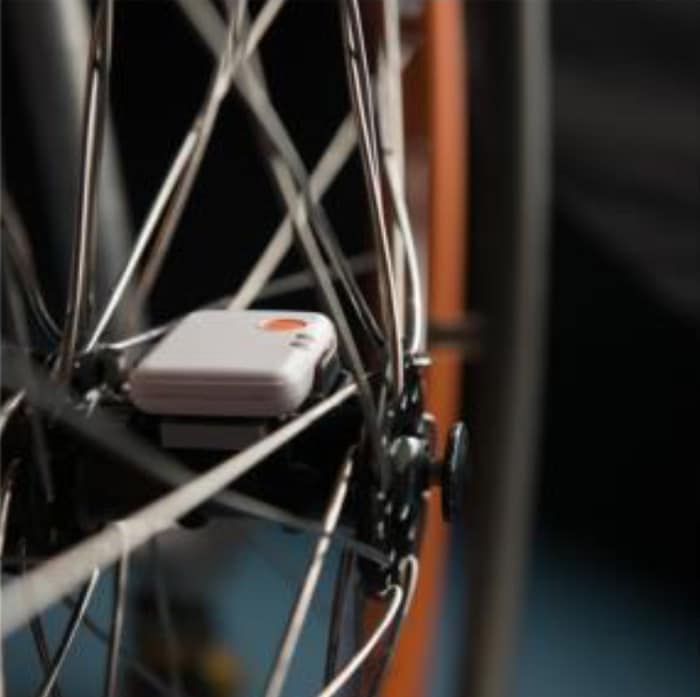Rienk van der Slikke, a student at the Delft University of Technology, recently developed a Shimmer based application to evaluate wheelchair mobility performance (WMP) and actually quantify that measure.
Background & Objectives
Performance in wheelchair sports is, to a large extent, determined by the wheelchair mobility performance (WMP): the performance measure for the wheelchair-athlete combination. So far, wheelchair mobility performance is mostly utilized as a concept, rather than a quantified measure. However, in order to gain insight into the interaction between athlete, wheelchair and sport, it should be an objective and a well quantified outcome that is easily measured.
Performance in wheelchair sports is determined by the interaction between athlete wheelchair and sport. The wheelchair is an extension of the athlete and should therefore be included in the performance measurement. Wheelchair sports have grown increasingly competitive over the years, so a better understanding of this three-way relationship can help improve wheelchair sports in general, as well as improve individual athlete performance and reduce injury risk.
System Overview
A celeritas 300 wheelchair was equipped with 3 markers and 3 inertial measurement units (IMU) measuring 3D linear acceleration, angular velocity and magnetic field orientation at a sampling rate of 256 Hz. Sensors were placed on the frame’s rear axis slightly right from the centre and on each wheel axis.

Marker positions were recorded with a 120 Hz, 24 infrared camera 3D motion capture system, serving as a ‘gold standard’. To enhance visibility range and to prevent disturbing reflections, battery powered infrared light emitting diodes (markers) were used instead of standard retro reflective markers. The markers were mounted on the wheelchair frame; two on the bumper bar and one on a rod at the front of the frame. IMU units and optical motion analysis were synchronized by hardwiring all IMU sensors to a pulse generator.
Integrating Shimmer
In order to quantify wheelchair mobility performance, a knowledge of wheelchair kinematics during a match needed to be established first. Using Shimmer’s IMU sensor, data was collected on the wheelchair’s frame displacement/speed and the frame’s rotation/rotational speed.
Frame displacement and speed were calculated by using wheel acceleration signals as inclination values to calculate angular orientation. A combined use of wheel IMU acceleration and gyroscope data incorporated the stability of the acceleration signal and the sensitivity of the corrected gyroscope signal into the used algorithm for wheel rotation.

Frame rotational speed in the horizontal plane was directly measured with the frame IMU and integration of this signal provided frame rotation. Additionally, the distance between the frame center and the instant center of rotation (IRC) were calculated twice, based on both left and right wheel acceleration.
Reliability of the IMU method was determined by analysis of the IMU-based deviation from ’gold standard’ data, expressed in overall difference and RMSE values. Additionally, for speed, rotational speed and IRC, mean test averages of the IMU method and ‘gold standard’ were calculated using the SPSS reliability analysis. In both cases, the three IMU configuration proved to be reliable for measuring wheelchair kinematics.
Quantification of Wheelchair Mobility Performance
Up until now, wheelchair mobility performance had only been utilized as a concept because no one had effectively developed methods that provided a comprehensive overview of the kinematics needed to accurately describe the effect of athlete-wheelchair interactions on performance in sport.
The newly developed inertial sensor-based method made it easy to bring forth a comprehensive set of wheelchair kinematic outcomes, including distance covered, speed, accelerations, rotations, rotational speed and rotational accelerations.

In order to develop these key kinematic outcomes, an agility track was used that required the subjects to perform 22 different tests that covered the major aspects of wheelchair basketball. Some of the tests used came from prior research that were then modified to meet necessary capture volume dimensions. The majority of the tests came from consultation with wheelchair basketball experts to ensure inclusion of all critical kinematic patterns.
Once all tests were completed by each of the subjects, 6 key kinematic outcomes that accurately described wheelchair mobility performance were composed. These outcomes enable comparison of different wheelchair sports and evaluation at the individual athlete level. This means that these outcomes can enhance further development of wheelchair sports in general.
Summary and Future Research
The goal of this research was to help enhance wheelchair sports by providing key kinematic outcomes of wheelchair basketball in an understandable way. These kinematic outcomes can then be used to configure wheelchairs in a way that suits the individual performance target and enhance overall play.

At the onset of this research project, there was a focus on wheelchair basketball. Yet, the method and principles were applicable to all court sports. So, as a first step towards application across wheelchair sports, match measurements with the wheelchair mobility performance monitor were performed at an elite level with wheelchair rugby, wheelchair tennis and wheelchair basketball athletes during international tournaments.
The developed method proved to be reliable for collecting kinematic wheelchair data. Wheelchairs can easily be equipped with lightweight IMU sensors, allowing for future research into a more detailed profile of wheelchair kinematics during a match. Combined with measurement of additional quantities, such as exerted force or observed game performance information, this allows for composition of an athlete specific performance profile. Such a profile could be used to determine the effect of sport specific training or wheelchair setting adjustment.

